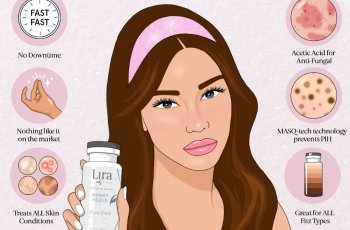We’ve already covered PHAs and how they’ve burst onto the beauty scene in recent years. Today we’re taking some time to learn more about a specific ingredient called galactose. What exactly is that? What effects can you expect from incorporating it into your daily skincare routine and whether it can actually benefit you and your skin type. So, without wasting any more time, let’s dive right in and take a look at this clever polyhydroxy acid and see what it can do for our skin.

What is galactose?
Galactose occurs naturally in the body as a sugar that is converted in the liver to provide energy to the body. While galactose is primarily used in food, there are many benefits to using skincare products that have this ingredient in their formula. There have been many studies examining the effectiveness of galactose and its effects on the skin as it has a range of antioxidant and prebiotic properties. It’s these properties that make this compound ideal for skincare products with exfoliating and conditioning benefits.
Galactose is part of the PHA family, a collection of chemical peels that represent a new generation of the very popular AHAs and BHAs. However, unlike their stronger cousins, PHAs gently exfoliate the skin, making them safe enough for all skin types. Even for those with sensitive skin and other skin issues like eczema, rosacea, and dermatitis.
What are the benefits of galactose for skin care?
When you use galactose, you can expect it to have a positive impact on the overall appearance of your skin. Some specific issues can be addressed in a slightly different way than using alpha hydroxy acids (AHAs) and beta hydroxy acids (BHAs). This is mainly because PHAs like galactose moisturize the skin when applied topically. This allows the skin’s natural protective barrier to work with the right amount of oil and water once moisture is locked into the skin. Signs of aging like fine lines and wrinkles are specifically combated, as well as dry skin areas and a buildup of dead skin cells.
Here are the main benefits of galactose:
Galactose is a chemical exfoliant, which means it removes dead skin cells that build up in the outer layer of the skin, leaving the complexion dull and dry, and causing some people to experience frequent breakouts and other blemishes.
Galactose can help reduce the appearance of dark spots and hyperpigmentation. Unlike other chemical acids like AHAs, it does not increase sun exposure, which means you will see results faster and dark spots will be visibly reduced.
When ingested and applied topically to the skin, galactose has antioxidant properties, meaning it can counteract the effects of overexposure to harmful free radicals such as pollution, climate, central heating, UV radiation and other environmental skin stressors.
Galactose is gentle on the skin while increasing the effectiveness of other ingredients that penetrate the skin. Therefore, galactose is a great asset to everyone’s skincare routine as all products can perform at their highest level.
Galactose is gentle enough for all skin types, including sensitive skin and those that often experience rosacea and eczema. You’ll find that irritation, dryness and redness are less of an issue than with stronger acids like salicylic and glycolic acid.
Galactose can be used in conjunction with other AHA and BHA ingredients (if your skin can tolerate it), which means you can use a well-established and effective blend of ingredients in your daily regimen to achieve more dramatic results in less time.
The moisturizing properties of galactose allow it to work well with ingredients like hyaluronic acid, glycerin, ceramides, and peptides. When you blend these ingredients together, the moisturizing benefits are enhanced, leaving your complexion looking hydrated.
These are some of the main benefits of using galactose in your daily routine, but I must stress that you should also make sure your skin is comfortable with the use of this ingredient. Perform a patch test, applying some to your forearm and leaving it on for 24 hours to see if it doesn’t irritate your skin. If you have concerns about using a new PHA, you must always seek further advice from your GP or doctor.
Which skin types can use galactose?
I’ve already briefly covered which skin types can use galactose with other PHAs, and that’s everyone! Yes, everyone really. As long as you perform a patch test as mentioned earlier and there are no signs of irritation, you can continue to use it.
The molecular size of galactose is very large, which means it can’t penetrate the lower layers of the skin and cause some irritation, unlike the more potent salicylic acid that is known to reach the lower layers of the skin.
How can you use galactose in your daily skincare routine?
Polyhydroxy acids like galactose can be added to a variety of skincare products, from cleansers to masks to moisturizers to serums. In recent years, many skincare users have made the switch, replacing their old scented floral water toners with chemical exfoliants from the broad hydroxy family of facial acids. Switching to an exfoliating toner will not only help you manage your overall skin tone, even out texture and tone, but it will also ensure that the subsequent steps in your routine are absorbed quickly and more effectively.
Although I’ve highlighted how gentle galactose and other PHAs are on the skin, it has a limited tolerance. Products rich in galactose should be used according to the directions on the package. This is not only important to ensure you’re using the product correctly, but also to avoid overdosing, which can lead to dry, uncomfortable, and irritated skin. If you want to choose the most effective galactose product, you’ll get the best results using a serum or moisturizer, as they’ll generally stay on the skin longer.
What Not to Mix with Galactose?
Although it’s easy to introduce galactose-rich products into your daily routine, there are some precautions you need to take when using them on a daily basis. This is mainly related to other products that contain very popular ingredients like vitamin C and vitamin A (such as retinoids). Since vitamin C is known to be unstable, it’s best not to use it at the same time as galactose. However, this doesn’t mean you can’t use both ingredients in your daily routine. For example, you can use a vitamin C serum in the morning and a galactose toner in the evening. This means your skin will fully benefit from both skin care ingredients without causing breakouts or irritation on the skin.
The same goes for using retinol, as overuse can lead to skin allergies. Therefore, alternating between retinol and galactose can keep your skin balanced, healthy, and happy.


